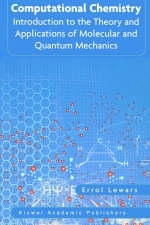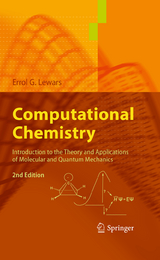
Computational Chemistry
Kluwer Academic Publishers (Verlag)
978-1-4020-7422-6 (ISBN)
- Titel erscheint in neuer Auflage
- Artikel merken
Computational chemistry has become extremely important in the last decade, being widely used in academic and industrial research. Yet there have been few books designed to teach the subject to nonspecialists. Computational Chemistry: Introduction to the Theory and Applications of Molecular and Quantum Mechanics is an invaluable tool for teaching and researchers alike. The book provides an overview of the field, explains the basic underlying theory at a meaningful level that is not beyond beginners, and it gives numerous comparisons of different methods with one another and with experiment. The following concepts are illustrated and their possibilities and limitations are given: - potential energy surfaces; - simple and extended Huckel methods; - ab initio, AM1 and related semiempirical methods; - density functional theory (DFT). Topics are placed in a historical context, adding interest to them and removing much of their apparently arbitrary aspect. The large number of references, to all significant topics mentioned, should make this book useful not only to undergraduates but also to graduate students and academic and industrial researchers.
Prof. Dr. E.G. Lewars Errol G. Lewars obtained his Ph.D. with Peter Yates at the University of Toronto, synthesizing "unnatural products", then worked with R. B. Woodward at Harvard on vitamin B12, and with J. F. King at the University of Western Ontario on organosulfur compounds. He is currently Professor of Chemistry at Trent University, Peterborough, Ontario, Canada. The development of methods which provided a realistic assessment of the properties of unknown compounds induced him to move into computational chemistry. His work "Computational Chemistry. An Introduction to the Theory and Applications of Molecular and Quantum Mechanics" (published by Kluwer, 2003) was named as CHOICE magazine's "Outstanding Academic Title" of 2004.
1: An outline of what computational chemistry is all about. 1.1. What you can do with computational chemistry. 1.2. The tools of computational chemistry. 1.3. Putting it all together. 1.4. The philosophy of computational chemistry. 1.5. Summary of Chapter 1. References. 2: The concept of the potential energy surface. 2.1. Perspective. 2.2. Stationary points. 2.3. The Born-Oppenheimer approximation. 2.4. Geometry optimization. 2.5. Stationary points and normal-mode vibrations. Zero point energy. 2.6. Symmetry. 2.7. Summary. References. 3: Molecular mechanics. 3.1. Perspective. 3.2. The basic principles of molecular mechanics. 3.3. Examples of the use of molecular mechanics. 3.4. Geometries calculated by MM. 3.5. Frequencies calculated by MM. 3.6. Strengths and weaknesses of molecular mechanics. 3.7. Summary of chapter 3. References. 4: Introduction to quantum mechanics in computational chemistry. 4.1. Perspective. 4.2. The development of quantum mechanics. The Schrodinger equation. 4.3. The application of the Schrodinger equation to chemistry by Huckel. 4.4. The Extended Huckel Method. 4.5. Summary of chapter 4. References. M 5: Ab initio calculations. 5.1. Perspective. 5.2. The basic principles of the ab initio method. 5.3. Basis sets. 5.4. Post-Hartree-Fock Calculations: electron correlation. 5.5. Applications of the ab initio method. 5.6. Strengths and weaknesses of ab initio calculations. 5.7. Summary of chapter 5. References. 6: Semiempirical calculations. 6.1. Perspective. 6.2. The basic principles of SCF semiempirical methods. 6.3. Applications of semiempirical methods. 6.4. Strengths and weaknesses of semiempirical methods. 6.5. Summary of chapter 6. References. 7: Density functional calculations. 7.1. Perspective. 7.2. The basic principles of density functional theory. 7.3. Applications of density functional theory. 7.4. Strengths and weaknesses of DFT. 7.5. Summary of chapter 7. References. 8: Literature, software, books and websites. 8.1. From the literature. 8.2. To the literature. 8.3. Software and hardware. Postscript. References. Index.
| Zusatzinfo | 1, black & white illustrations |
|---|---|
| Sprache | englisch |
| Maße | 156 x 234 mm |
| Gewicht | 673 g |
| Einbandart | Paperback |
| Themenwelt | Informatik ► Grafik / Design ► Digitale Bildverarbeitung |
| Naturwissenschaften ► Chemie | |
| ISBN-10 | 1-4020-7422-0 / 1402074220 |
| ISBN-13 | 978-1-4020-7422-6 / 9781402074226 |
| Zustand | Neuware |
| Haben Sie eine Frage zum Produkt? |
aus dem Bereich



